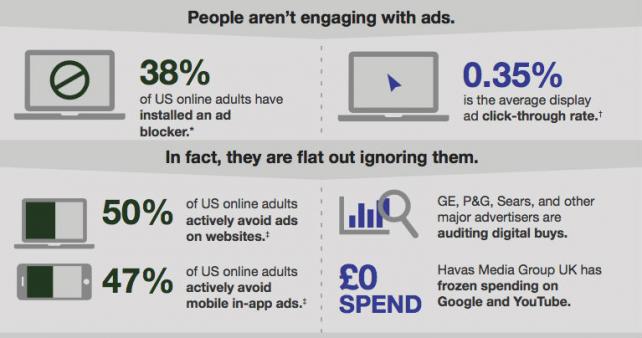It’s a perfect storm of bad news for digital advertising.
“Moves by big advertisers to pause spending on Google, audit media buying and demand greater accountability will at least dent the rise of digital ad spending and hasten what Forrester is calling ‘The End of Advertising As We Know It’ in a report to be released today,” writes Jack Neff in Ad Age.
That report urges CMOs to shift billions of their ad spend from interruptive digital ads to branded relationships.
At the heart of the problem is the consumer: people just aren’t engaging with ads, and ad blocker usage continues to climb.

Credit: Forrester
“Google’s recent street-beating revenue results, despite those spending pauses that began in mid-March, may make digital ad spending growth look inevitable,” Neff continues. “But Forrester isn’t buying it, projecting big advertisers will pull around $2.9 billion out of digital advertising over the next year.”
Folks, this is huge. CMOs are admitting that digital display ads have “never worked like we pretended,” the Forrester report notes. The big pullout is being led by Procter & Gamble, whose brand officer recently told the digital ad industry to “grow up.”
So where is the future for digital advertising? According to James McQuivey, a lead analyst on the report, brands should be looking at alternatives.
“He doesn’t mean the TV upfront, though Forrester cites projections of a healthy 4.5% bump this year by Media Dynamics,” Neff explains. “Instead, he’s talking ‘persistent personal assistants.’”
The trend is for consumers to choose “options for getting what they want without interruptions,” McQuivey said, citing Apple’s Siri, Amazon Echo, Google Home, Google Assistant and Facebook Messenger or WhatsApp chatbots as examples.
He believes that once consumers can get what they need without interruptions, their tolerance for interruptive advertising will continue to plummet. In place of those interruptions, consumers are seeking – and brands can profit from – “deeper relationships with the companies that matter to them,” McQuivey said.
This won’t spell the end of digital ads entirely, but the industry is waking up to the fact that there is – there must be – a better way for brands to connect in real time.
